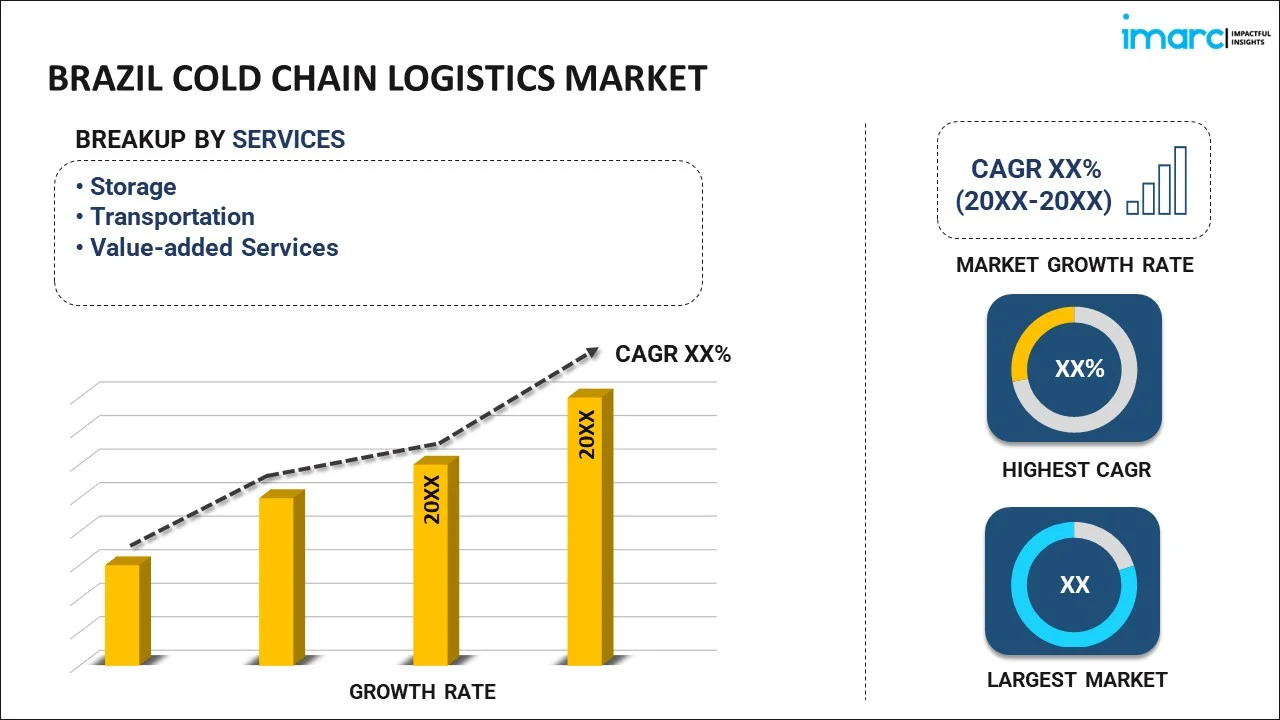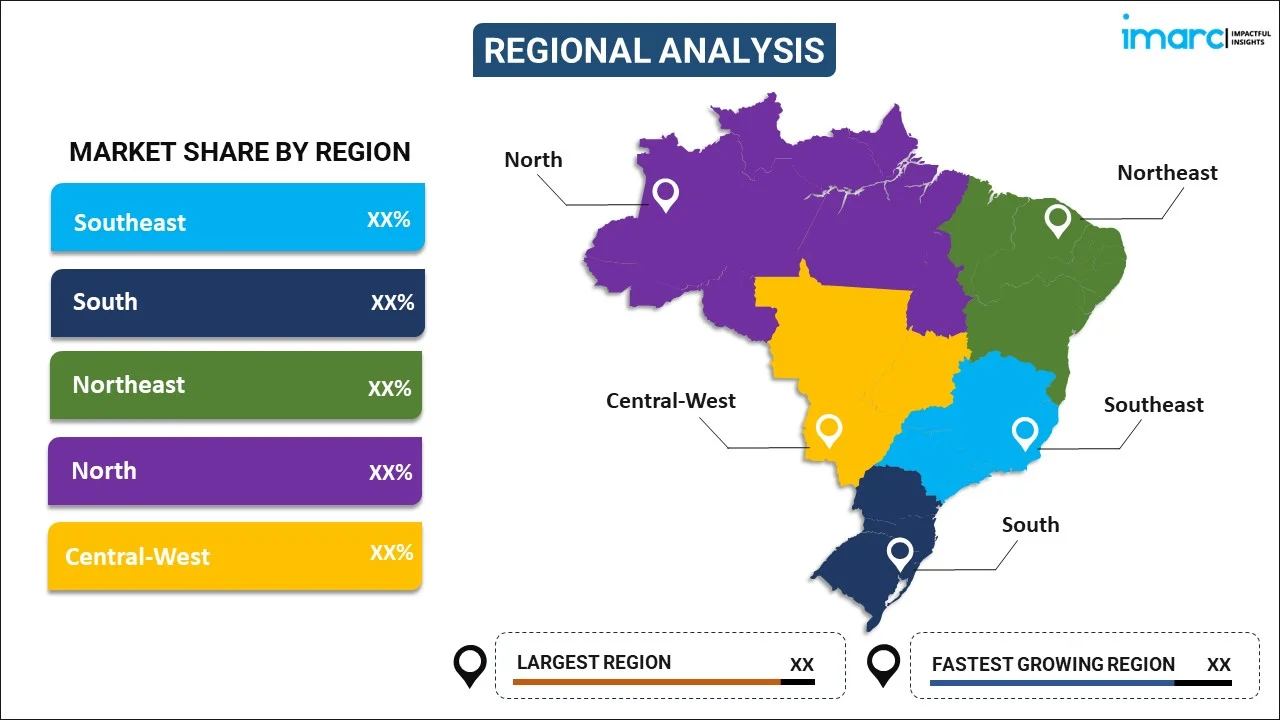
Brazil Cold Chain Logistics Market Report by Service (Storage, Transportation, Value-added Services), Temperature Type (Chilled, Frozen), Application (Horticulture (Fresh Fruits and Vegetables), Meats, Fish, and Poultry, Processed Food Products, Pharmaceuticals, Life Sciences, and Chemicals, and Others), and Region 2024-2032
Market Overview:
Brazil cold chain logistics market size reached US$ 2.4 Billion in 2023. Looking forward, IMARC Group expects the market to reach US$ 5.3 Billion by 2032, exhibiting a growth rate (CAGR) of 9.23% during 2024-2032. The growing need for safe storage and distribution of temperature-sensitive medicines, increasing demand for fresh and frozen products, and improving cold storage facilities and temperature-controlled transportation infrastructure represent some of the key factors driving the market.
|
Report Attribute
|
Key Statistics
|
|---|---|
|
Base Year
|
2023
|
|
Forecast Years
|
2024-2032
|
|
Historical Years
|
2018-2023
|
|
Market Size in 2023
|
US$ 2.4 Billion |
|
Market Forecast in 2032
|
US$ 5.3 Billion |
| Market Growth Rate 2024-2032 | 9.23% |
Cold chain logistics refers to the specialized method of managing and transporting temperature-sensitive goods throughout the supply chain to ensure their quality and safety. It can slow down the natural deterioration of goods and reduce waste by controlling temperature and humidity levels. It transports perishable products, such as food items, vaccines, and other temperature-sensitive commodities, that require controlled temperature environments, typically in the form of refrigeration or freezing. It helps companies comply with regulations by providing a documented and controlled environment for transportation and storage. It offers a more efficient supply chain by reducing the risk of disruptions, lowering delays, and ensuring timely deliveries. It assists in maintaining the integrity of these goods, preventing spoilage, degradation, or contamination during transportation and storage. It aids in extending the shelf life of the products, which increases the profitability of a business. As it is beneficial in safeguarding the product efficacy, the demand for cold chain logistics is rising in Brazil.
Brazil Cold Chain Logistics Market Trends:
At present, the increasing need for safe storage and distribution of temperature-sensitive medicines represents one of the major factors influencing the market positively in Brazil. Additionally, the rising adoption of eco-friendly practices, such as using energy-efficient refrigeration systems and sustainable packaging, that reduce the carbon footprint and promote environmental sustainability, is impelling the market growth in Brazil. Besides this, the growing adoption of cold chain logistics due to the increasing demand for fresh and frozen products among individuals is offering a positive market outlook. Moreover, the rising adoption of advanced technologies like the Internet of Things (IoT) sensors and real-time monitoring to enhance visibility and control over temperature-sensitive shipments is offering lucrative growth opportunities to industry investors in Brazil. In line with this, the increasing employment of cold chain logistics on account of the burgeoning e-commerce sector is strengthening the market growth in the country. Apart from this, there is a rise in the demand for precise cold chain logistics to distribute sensitive pharmaceuticals, such as vaccines and biologics. This, coupled with the increasing adoption of specialized cold chain logistics to maintain the quality and efficacy of organic and specialty products, is contributing to the growth of the market. Furthermore, improving cold storage facilities and temperature-controlled transportation infrastructure in Brazil is bolstering the market growth. In addition, the increasing adoption of cold chain logistics to ensure supplies during emergencies, along with the rising number of natural disasters, is supporting the market growth in the country.
Brazil Cold Chain Logistics Market Segmentation:
IMARC Group provides an analysis of the key trends in each segment of the market, along with forecasts at the country level for 2024-2032. Our report has categorized the market based on service, temperature type, and application.
Service Insights:

- Storage
- Transportation
- Value-added Services
The report has provided a detailed breakup and analysis of the market based on the service. This includes storage, transportation, and value-added services.
Temperature Type Insights:
- Chilled
- Frozen
A detailed breakup and analysis of the market based on the temperature type have also been provided in the report. This includes chilled and frozen.
Application Insights:
- Horticulture (Fresh Fruits and Vegetables)
- Meats, Fish, and Poultry
- Processed Food Products
- Pharmaceuticals, Life Sciences, and Chemicals
- Others
The report has provided a detailed breakup and analysis of the market based on the application. This includes horticulture (fresh fruits and vegetables), meats, fish, and poultry, processed food products, pharmaceuticals, life sciences, and chemicals, and others.
Regional Insights:

- Southeast
- South
- Northeast
- North
- Central-West
The report has also provided a comprehensive analysis of all the major regional markets, which include Southeast, South, Northeast, North, and Central-West.
Competitive Landscape:
The market research report has also provided a comprehensive analysis of the competitive landscape in the market. Competitive analysis such as market structure, key player positioning, top winning strategies, competitive dashboard, and company evaluation quadrant has been covered in the report. Also, detailed profiles of all major companies have been provided.
Brazil Cold Chain Logistics Market Report Coverage:
| Report Features | Details |
|---|---|
| Base Year of the Analysis | 2023 |
| Historical Period | 2018-2023 |
| Forecast Period | 2024-2032 |
| Units | US$ Billion |
| Scope of the Report | Exploration of Historical Trends and Market Outlook, Industry Catalysts and Challenges, Segment-Wise Historical and Future Market Assessment:
|
| Services Covered | Storage, Transportation, Value-added Services |
| Temperature Types Covered | Chilled, Frozen |
| Applications Covered | Horticulture (Fresh Fruits and Vegetables), Meats, Fish, and Poultry, Processed Food Products, Pharmaceuticals, Life Sciences, and Chemicals, Others |
| Regions Covered | Southeast, South, Northeast, North, Central-West |
| Customization Scope | 10% Free Customization |
| Report Price and Purchase Option | Single User License: US$ 3699 Five User License: US$ 4699 Corporate License: US$ 5699 |
| Post-Sale Analyst Support | 10-12 Weeks |
| Delivery Format | PDF and Excel through Email (We can also provide the editable version of the report in PPT/Word format on special request) |
Key Questions Answered in This Report:
- How has the Brazil cold chain logistics market performed so far and how will it perform in the coming years?
- What has been the impact of COVID-19 on the Brazil cold chain logistics market?
- What is the breakup of the Brazil cold chain logistics market on the basis of service?
- What is the breakup of the Brazil cold chain logistics market on the basis of temperature type?
- What is the breakup of the Brazil cold chain logistics market on the basis of application?
- What are the various stages in the value chain of the Brazil cold chain logistics market?
- What are the key driving factors and challenges in the Brazil cold chain logistics?
- What is the structure of the Brazil cold chain logistics market and who are the key players?
- What is the degree of competition in the Brazil cold chain logistics market?
Key Benefits for Stakeholders:
- IMARC’s industry report offers a comprehensive quantitative analysis of various market segments, historical and current market trends, market forecasts, and dynamics of the Brazil cold chain logistics market from 2018-2032.
- The research report provides the latest information on the market drivers, challenges, and opportunities in the Brazil cold chain logistics market.
- Porter's five forces analysis assist stakeholders in assessing the impact of new entrants, competitive rivalry, supplier power, buyer power, and the threat of substitution. It helps stakeholders to analyze the level of competition within the Brazil cold chain logistics industry and its attractiveness.
- Competitive landscape allows stakeholders to understand their competitive environment and provides an insight into the current positions of key players in the market.
Need more help?
- Speak to our experienced analysts for insights on the current market scenarios.
- Include additional segments and countries to customize the report as per your requirement.
- Gain an unparalleled competitive advantage in your domain by understanding how to utilize the report and positively impacting your operations and revenue.
- For further assistance, please connect with our analysts.
 Inquire Before Buying
Inquire Before Buying
 Speak to an Analyst
Speak to an Analyst
 Request Brochure
Request Brochure
 Request Customization
Request Customization




.webp)




.webp)












